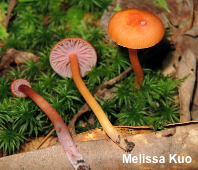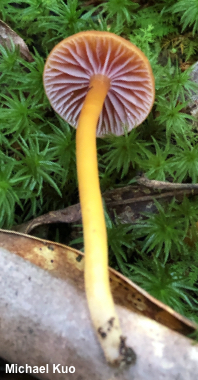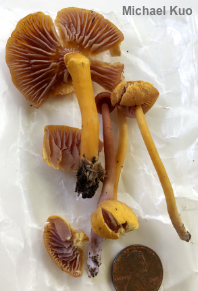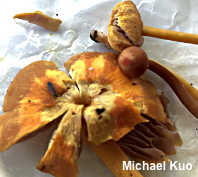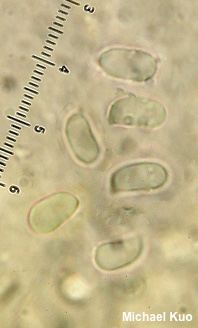| Major Groups > Gilled Mushrooms > Pale-Spored > Waxy Caps > Hygrocybe purpureofolia |

|
Hygrocybe purpureofolia [ Basidiomycota > Agaricales > Hygrophoraceae > Hygrocybe . . . ] by Michael Kuo Orange and red waxy caps are not the easiest mushrooms to identify, but this one stands out from the crowd once you turn it over: its gills are a dusky shade of purple. Found in the Appalachian Mountains, Hygrocybe purpureofolia starts out reddish orange, then fades and dries out rather dramatically from the center outwards, turning first bright orange, then a wishy-washy brownish yellow. The stem is orange to yellow, hollow, and features white or purplish basal mycelium. Hygrocybe mephitica is a similar species with dull purple gills, first described by Peck (1906) from Massachusetts; it grows in sphagnum bogs and features a "yellowish-brown" cap that is "sometimes tinged with green," along with a strong, unpleasant odor. Peck appears to have described the species based on a collection made by someone else ("S. Davis"), some days after the collection was made—which makes me wonder about the possibility that it is the same thing as Hygrocybe purpureofolia (in which case Peck's name is older and would have priority). Peck's "yellowish brown" is a plausible match for the past-fresh color of Hygrocybe purpureofolia, although I don't know what to do with "tinged with green" other than attribute it to algae or mold. My collection of Hygrocybe purpureofolia was made in sphagnum, and while it did not have a distinctive odor when fresh, it filled my lab with an unpleasant stink when I rehydrated a cap section for study. Hygrophorus purpureofolius is a synonym. Thanks to Sherwood Forest Friends for facilitating collection of specimens. Description: Ecology: Precise ecological role uncertain (see Lodge and collaborators, 2013); appearing in forests, often with eastern hemlock present; growing gregariously; summer and fall; Appalachian Mountains. The illustrated and described collection is from North Carolina. Cap: 2–5 cm across; convex, expanding to broadly convex or nearly flat; dry, or a little moist when fresh; bald; reddish orange to orange when fresh, fading markedly from the center to the margin as it dries out, becoming first bright orange, then brownish yellow to dull yellowish brown; thin and fragile. Gills: Broadly attached to the stem; nearly distant; short-gills frequent; dull purple. Stem: 4–7 cm long; 3–7 mm thick; more or less equal; dry; bald; orange, fading to yellow; hollow; basal mycelium white or slightly purplish. Flesh: Yellowish; not changing on exposure. Odor: Not distinctive when fresh, but rehydrated herbarium material has a strongly unpleasant odor. Chemical Reactions: KOH on cap surface negative. Spore Print: White. Microscopic Features: Spores 7–9 x 4–4.5 µm; ellipsoid or occasionally a little constricted; smooth; hyaline in KOH; inamyloid. Basidia 4-sterigmate; 35–50 µm long. Hymenial cystidia not found. Lamellar trama parallel. Pileipellis an ixotrichoderm; elements 2.5–7.5 µm wide, smooth, hyaline in KOH. REFERENCES: (Bigelow, 1960) Courtecuisse, 1989. (Hesler & Smith, 1963; Phillips, 1991/2005; Bessette et al., 2012; Lodge et al., 2013; Sturgeon, 2018.) Herb. Kuo 08091903. This website contains no information about the edibility or toxicity of mushrooms. |
|
|
Cite this page as: Kuo, M. (2020, February). Hygrocybe purpureofolia. Retrieved from the MushroomExpert.Com Web site: http://www.mushroomexpert.com/hygrocybe_purpureofolia.html ©MushroomExpert.Com |
